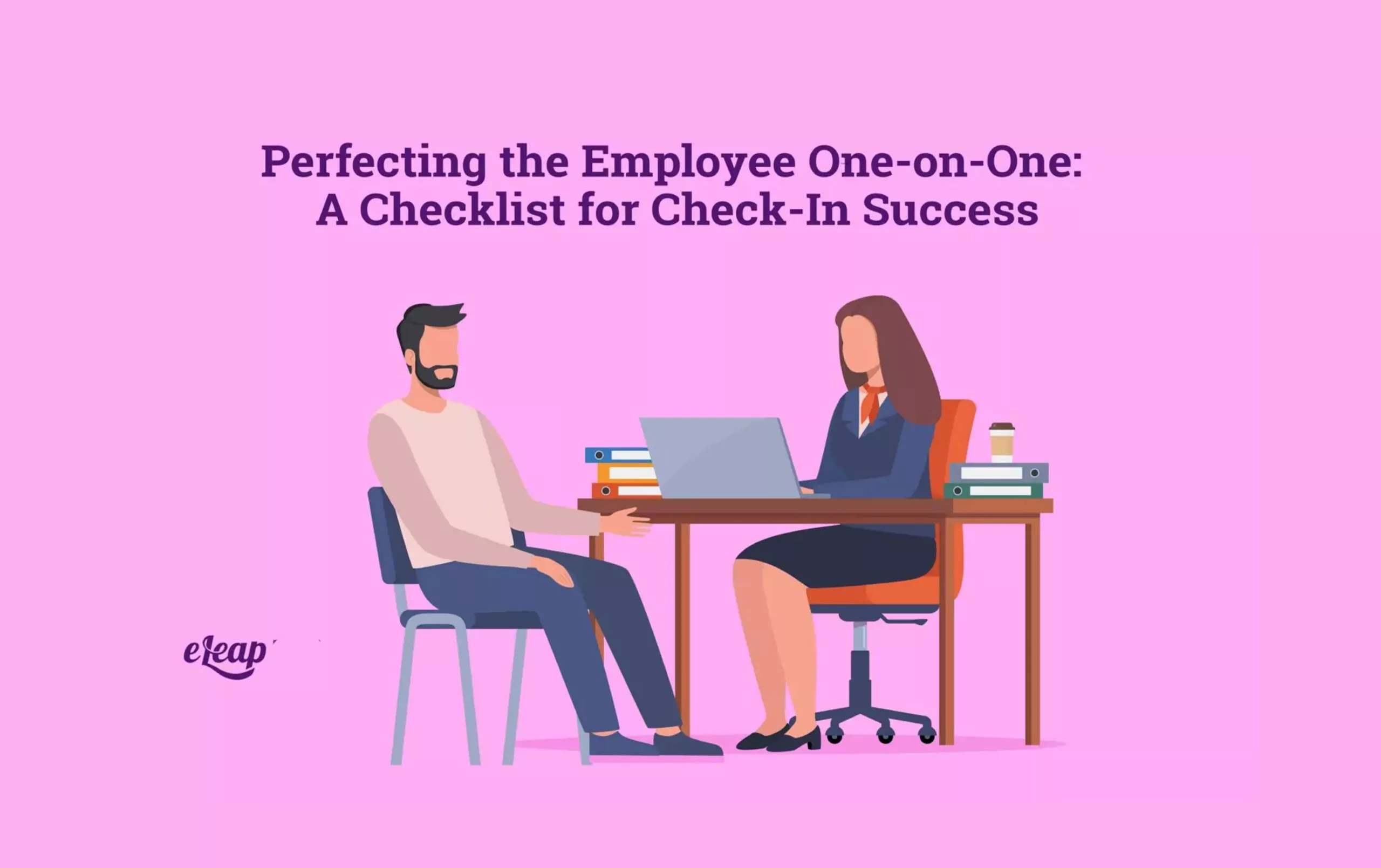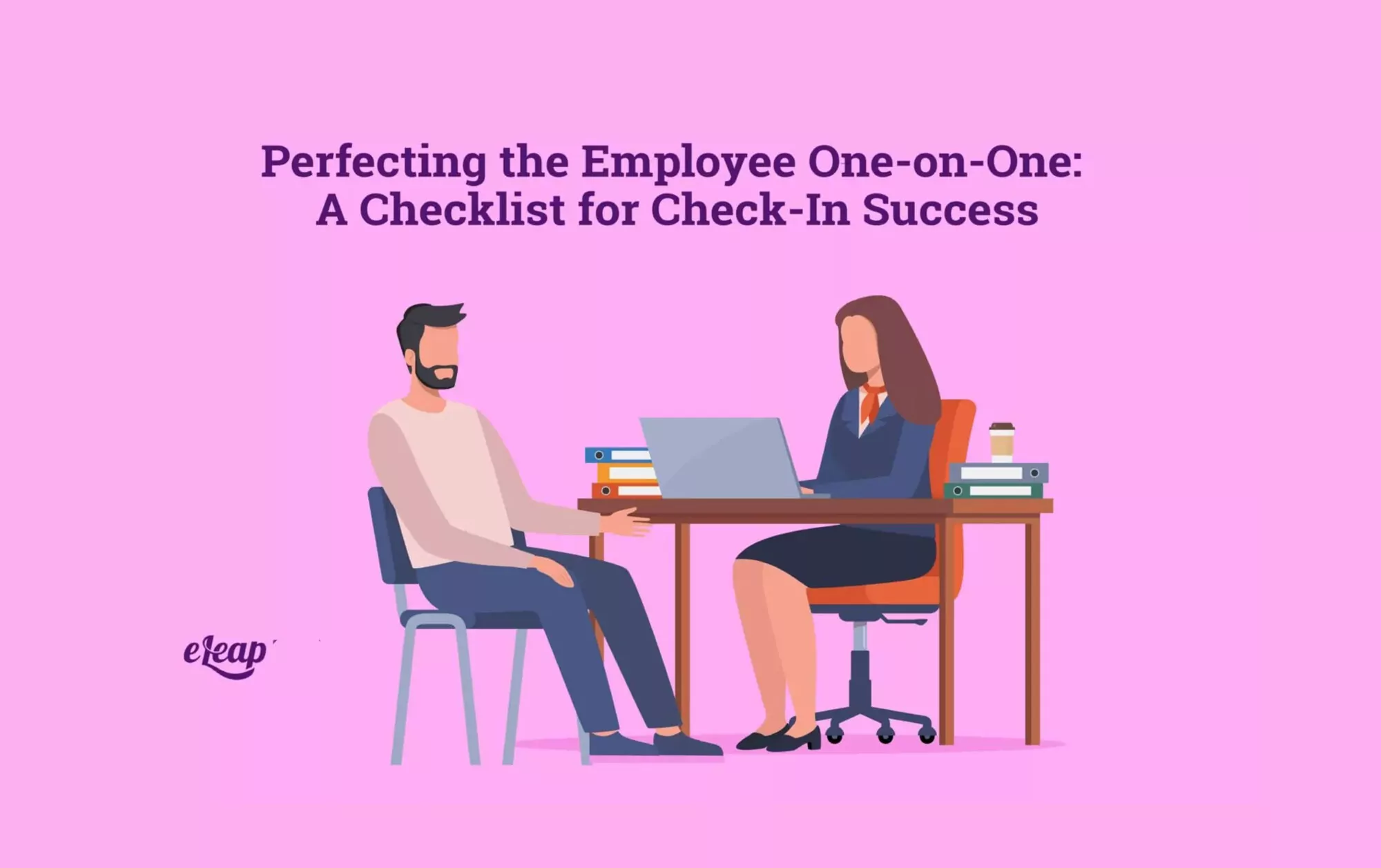Perfecting the Employee One-on-One: A Checklist for Check-In Success

In order to prepare for a one-on-one meeting with an employee, you need to have a strategy in place that focuses on their development. Gone are the days when you could simply follow the arbitrary review model and use recycled questions and talking points to go through the process. Today’s employee wants a more targeted, personalized approach. The eLeaP People Success Platform has the tools and resources you need for effective one-on-ones and check-ins.
They also want that feedback more than just once a year as part of their annual performance review. Annual reviews are great, but what’s better is a culture that embraces ongoing feedback. What you say is just as important as how you say it, so here are some tips for creating effective one-on-ones to maximize growth for both individuals and the company.
What is a One-on-One with Employees?
Many managers simply avoid one-on-one meetings and reviews with their employees, or they stick to the annual performance review model. The problem with both of these “answers” is that they’re not effective at helping employees grow and thrive in their roles. It’s also not easy to keep up with accountability and goal achievement when you don’t have a formal process in place.
A one-on-one is a chance for both parties to sit down and discuss how things are going. It can involve several questions or prompts, as well as a wide range of topics. The success of these meetings comes from taking the time to personalize them and deliver a better feedback experience for employees.
These meetings can be formal or informal. That is, you can have a scheduled meeting where performance is the topic of discussion, and you talk about important metrics that need to be met. Or, you can simply have a weekly check-in with your team members to see how things are going and what they need assistance with.
No matter how you shape it, a one-on-one with an employee and their manager(s) will ensure that everyone is on the same page. It will also allow your employees to upskill and improve themselves professionally.
When you do it right, there are several benefits your company will experience.

The Benefits of the One-on-One
One-on-one meetings are a great way to sit down and analyze how things are going. They offer a chance for people to step back and take a look at what they’ve accomplished as well as to identify potential areas of improvement. Some of the biggest perks of the employee one-on-one include:
- Stronger relationships between managers and employees
- Improved productivity and efficiency
- Increased loyalty
- Personalized and value-added feedback
- Employees who are empowered to take accountability for their performance
- Engagement and communication improvements
- Offers support and drives employee performance in the workplace
This is not an exhaustive list, mind you. However, these are the most common benefits that people cite when they’re looking for reasons to improve their performance reviews and one-on-one meetings.
Being able to check in on progress and goals will ensure that your people are always aligned with their roles and responsibilities. Here’s how to do that effectively.
Your Checklist for Effective One-on-Ones and Feedback
As part of your planning and development for the one-on-one process, you need to take the time to create a checklist that covers every aspect of the meeting. From planning and research to follow-up and check-ins, you must set the right mood and ask the right questions. Let’s look at the items that need to be on everyone’s list.
Do Your Homework Ahead of Time
Managers are going to be able to deliver better performance reviews if they take the time to do their homework in advance. Set the context that this is a human discussion, not just a benchmark meeting that’s forced and unhelpful. Make sure that you know whether their performance is good or if it needs improvement.
You should also use this time to consider what you want out of the meeting or review process. That will help you come up with a solid outline for the meeting and ensure that you’re setting your team up for success. This part of the process includes research to determine your preferred one-on-one style as well as where performance stands currently so you can help people improve.
Set Your Meeting Agenda and Make a Plan
Again, these shouldn’t be a free-for-all type of meeting where there is no real structure. While many people shy away from an agenda because they’re afraid it leads back to the same old performance review concept that isn’t helpful to anyone. It’s actually quite the opposite.
When you take the time to come up with an agenda and a plan for helping employees improve, you’ll be able to see more success in the process as you go along. It might take some time to get everything perfect, but it is worth the effort.
Start with Simple Conversation
The problem for most employees is that performance reviews can be intimidating and uncomfortable when they’re not framed and presented properly. Every review should start with a casual conversation that gets the pulse on how employees feel and how leadership feels about the employees. This builds trust and shows authentic compassion.
Ask for Updates on Goals and Objectives
Before you dig into the details of the review process, ask your employees to provide you with an update on their own goals and achievements. These should have been set in previous meetings, and they will be aligned with the company’s goals in most cases. People may not know how to provide you with updates, so be sure to use leading words and help them figure out how to determine where they stand.
In addition to helping you understand where people are at, this also creates ownership and accountability.
Consider Personal Development Goals, Too
Employees are not just work machines. They are human beings with personal feelings and goals, along with professional development goals and dreams. Too often, companies focus on work and don’t allow people to have a personal life in the workplace. However, these are people who have lives and goals, and sometimes it’s worthwhile to remove work from the equation.
Discuss Challenges and Barriers
Now that you’ve gotten the feel-good discussion started, it’s time to approach the rest of the conversation. That includes having an open discussion about any barriers or potential challenges that could arise as employees are working toward their goals. This is an important conversation because it allows leaders to set the stage.
Instead of people seeing barriers as obstacles they can’t overcome, you can frame them so that they see these as challenges that will help them become better and reach their goals faster.
Give People Accountability
There is a lot that you can do to improve your organization, but if you aren’t giving employees accountability and ownership over their roles, development, and other aspects, it won’t matter. People need accountability. They need to feel like they own their role and their future success. No longer do people just want to work and let someone else figure out the details.
Employees who take accountability and ownership seriously are far more likely to outperform those who struggle to be accountable for their roles. They also offer more innovative solutions for the company and are more likely to contribute to the greater good of the team without being asked.
Take Notes for Coaching and More
There is never going to be a “perfect” one-on-one. Just as with performance, there is always room for improvement. Therefore, while you’re taking notes to monitor performance, you should also take notes for future coaching needs. Adding your own personal insights will also help you track performance and deliver a better review process.
Follow Up and Follow Through
Finally, you must follow up with your employees regularly. You need to create a review process that offers ongoing feedback and regular meetings. Consistency is key here. Develop and implement a strong feedback culture and a successful one-on-one strategy and stick to it every time.
How Often Should One-on-One Meetings Happen?
There is no simple or single answer here. There are several variables to consider, and ultimately, it will be up to you to figure out the ideal frequency and create a strategic performance review process. This will ensure that you can create an effective solution and deliver consistent results.
Make sure that you sit down with business leaders and employees alike. See how often people want or need feedback. Consider brief weekly check-ins that are part of a larger quarterly or bi-annual review, for example.
If you’re adopting the new 360-degree feedback model and looking to create an ongoing conversation, there should be several instances for these one-on-ones. As part of your planning, create a strategy that includes structure for the frequency of these meetings and other feedback conversations.
It’s about Creating the Conversations, Not Just Checking Off the Lists
A little attention to planning can go a long way in helping you deliver a better one-on-one meeting with any employee in your organization. Today’s employees want dedicated insights, and they want to feel like they’re a part of something bigger. When you use one-on-one meetings with employees effectively, you can convey this and help your team strive for excellence.